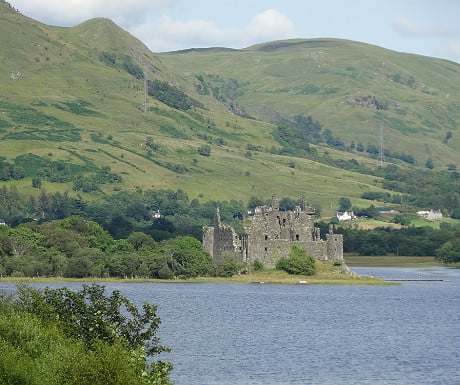You could be forgiven for not knowing about Kilchurn Castle. A castle like this in England would not only be well sign-posted, but you’d also be charged entry to go in. In Scotland on the other hand, there’s not so much as a single sign from the road. It was only on reaching the village of Loch Awe, lying on a loch of the same name, that we started to wonder whether we had already passed it.
We called in at a small shop to check on directions, only to find we had gone about a mile past. Indeed, on looking back, there it was in all its glory.

We headed back and found a short trail accessible from a small car park just off the main A85 road. Only then could you see a tiny sign that simply read “To the castle”.


The approach to the castle was a picturesque one and less than a mile from the car park. It is today maintained by Historic Scotland but there is no fee to visit.

Kilchurn Casle was originally built by Sir Colin Campbell in the mid-fifteenth century as a five-storey tower house, then on an island in the loch, and saw various additions in the 200 years that followed. In 1689, after James II of England had fled to France, William III and Mary II were proclaimed as co-rulers of England, Scotland and Ireland, resulting in a new role for Kilchurn Castle as Sir John Campbell of Glenorchy converted it into a barracks capable of holding 200 troops in the decade that followed. These efforts were overshadowed by the government’s development of Fort William just before the turn of the century, but the castle was used as a garrison by the government garrison during the 1715 and 1745 Jacobite Rebellions.

Arguably one of the most intriguing features at Kilchurn Castle today is what looks like a podium-like structure on the ground, inside the castle walls. This is in fact the top of an overturned circular tower, dramatically blown away from the castle by a lightning strike in 1760.

Despite this and other events, significant portions of the castle remain intact and you can climb up some sections and admire views of the loch in both directions. From here you can also get a sense of the original powerbase of Clan Campbell.



After a bit more exploring, we circled the exterior of the castle on our bikes – this is worth doing to get a fuller appreciation of the building since it looks different from different angles – before returning to the main road and continuing on with our journey.

The castle would have been easy to miss, but proved to be well worth the visit… muddy puddles and all!

Disclosure: The above formed part of a luxury Scotland mountain bike trip sponsored by Caledonian MacBrayne, Ridgeback and Madison.

Post a Comment